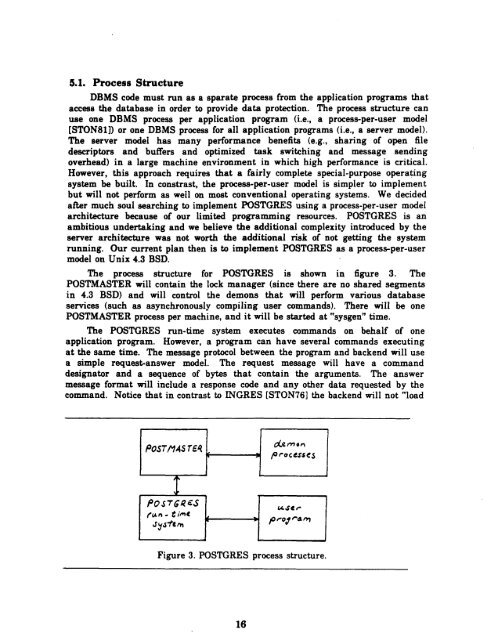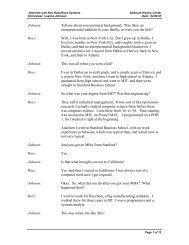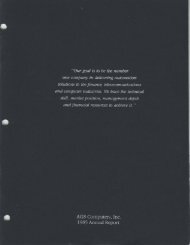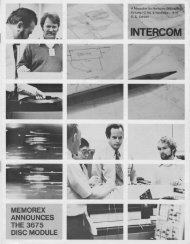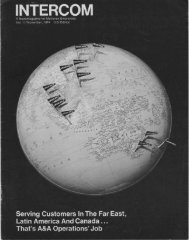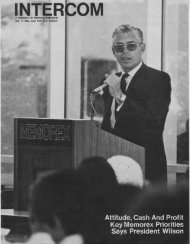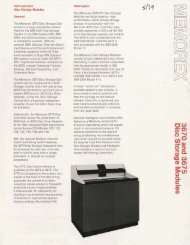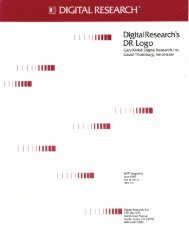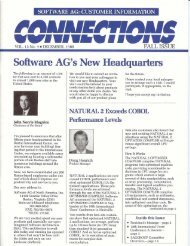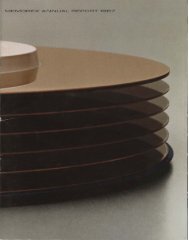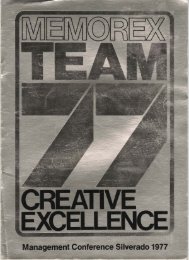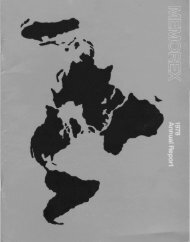command that was used to update <strong>the</strong> employee's salary field. The program couldappend <strong>the</strong> command, with suitable parameters, to <strong>the</strong> CODE catalog as follows:append to CODE(id = 1, owner = "browser",command ="replace EMP(aa1ary = $1) where EMP.name = $2")"$1" and "$2" denote <strong>the</strong> arguments to <strong>the</strong> command. Now, to execute <strong>the</strong> Replacecommand that updates Smith's salary shown above, <strong>the</strong> program executes <strong>the</strong>following command:execute (CODE.comrnand)with (NewSalary, "Smith")where CODE.id = 1 and CODE.owner ="browsernThis command executes <strong>the</strong> Replace command after substituting <strong>the</strong> arguments.Executing commands stored in <strong>the</strong> CODE catalog does not by itself make <strong>the</strong>command run any faster. However, a compilation demon is always executing thatexamines <strong>the</strong> entries in <strong>the</strong> CODE catalog in every database and compiles <strong>the</strong>queries. Assuming <strong>the</strong> compilation demon has compiled <strong>the</strong> Replace command inCODE, <strong>the</strong> query should run substantially faster because <strong>the</strong> time to parse andoptimize <strong>the</strong> query is avoided. Section 5 describes a general purpose mechanismfor invalidating compiled queries when <strong>the</strong> schema changes.Compiled queries are faster than queries that are parsed and optimized atrun-time but for some applications, even <strong>the</strong>y are not fast enough. The problem isthat <strong>the</strong> Execute command that invokes <strong>the</strong> compiled query still must be processed.Consequently, a fast-path facility is provided that avoids this overhead. In <strong>the</strong>Execute command above, <strong>the</strong> only variability is <strong>the</strong> argument list and <strong>the</strong> uniqueidentifier that selects <strong>the</strong> query to be run. HITCHING POST has a run-timeroutine that allows this information to be passed to <strong>the</strong> backend in a binary format.For example, <strong>the</strong> following function call invokes <strong>the</strong> Replace command describedabove:exec-fp( 1, "browser", NewSalary, "Smith")This function sends a message to <strong>the</strong> backend that includes only <strong>the</strong> informationneeded to determine where each value is located. The backend retrieves <strong>the</strong>compiled plan (possibly from <strong>the</strong> buffer pool), substitutes <strong>the</strong> parameters withouttype checking, and invokes <strong>the</strong> query plan. This path through <strong>the</strong> backend ishand-optimized to be very fast so <strong>the</strong> overhead to invoke a compiled query plan isminimal.This subsection has described facilities that allow an application programmerto improve <strong>the</strong> performance of a program by compiling queries or by using a specialfast-path facility.5. SYSTEM ARCHITECTUREThis section describes how we propose to implement POSTGRES. The firstsubsection describes <strong>the</strong> process structure. The second subsection describes howquery processing will be implemented, including fields of type POSTQUEL,procedure, and user-defined data type. The third subsection describes how alerters,triggers, and rules will be implemented. And finally, <strong>the</strong> fourth subsectiondescribes <strong>the</strong> storage system for implementing time varying data.
5.1. Process StructureDBMS code must run as a sparate process from <strong>the</strong> application programs thataccess <strong>the</strong> database in order to provide data protection. The process structure canuse one DBMS process per application program (i.e., a process-per-user model[STONOl]) or one DBMS process for all application programs (i.e., a server model).The server model has many performance benefits (e.g., sharing of open filedescriptors and buffers and optimized task s~tching and message sendingoverhead) in a large machine environment in which high performance is critical.However, this approach requires that a fairly complete special-purpose operatingsystem be built. In constrast, <strong>the</strong> process-per-user model is simpler to implementbut will not perform as well on most conventional operating systems. We decidedafter much soul searching to implement POSTGRES using a process-per-user modelarchitecture because of our limited programming resources. POSTGRES is anambitious undertaking and we believe <strong>the</strong> additional complexity introduced by <strong>the</strong>server architecture was not worth <strong>the</strong> additional risk of not getting <strong>the</strong> systemrunning. Our current plan <strong>the</strong>n is to implement POSTGRES as a process-per-usermodel on Unix 4.3 BSD.The process structure for POSTGRES is shown in figure 3. ThePOSTMASTER will contain <strong>the</strong> lock manager (since <strong>the</strong>re are no shared segmentsin 4.3 BSD) and will control <strong>the</strong> demons that will perform various databasese~ces (such as asynchronously compiling user commands). There will be onePOSTMASTER process per machine, and it will be started at "sysgen" time.The POSTGRES run-time system executes commands on behalf of oneapplication program. However, a program can have several commands executingat <strong>the</strong> same time. The message protocol between <strong>the</strong> program and backend will usea simple request-answer model. The request message will have a commanddesignator and a sequence of bytes that contain <strong>the</strong> arguments. The answermessage format will include a response code and any o<strong>the</strong>r data requested by <strong>the</strong>command. Notice that in contrast to INGRES [STON761 <strong>the</strong> backend will not "loadPOSTM4S TE4,Bdemanprocessej.POsTCRGSfun - time~ y ~ t e m LUserpro~~arr)1Figure 3. POSTGRES process structure.w


